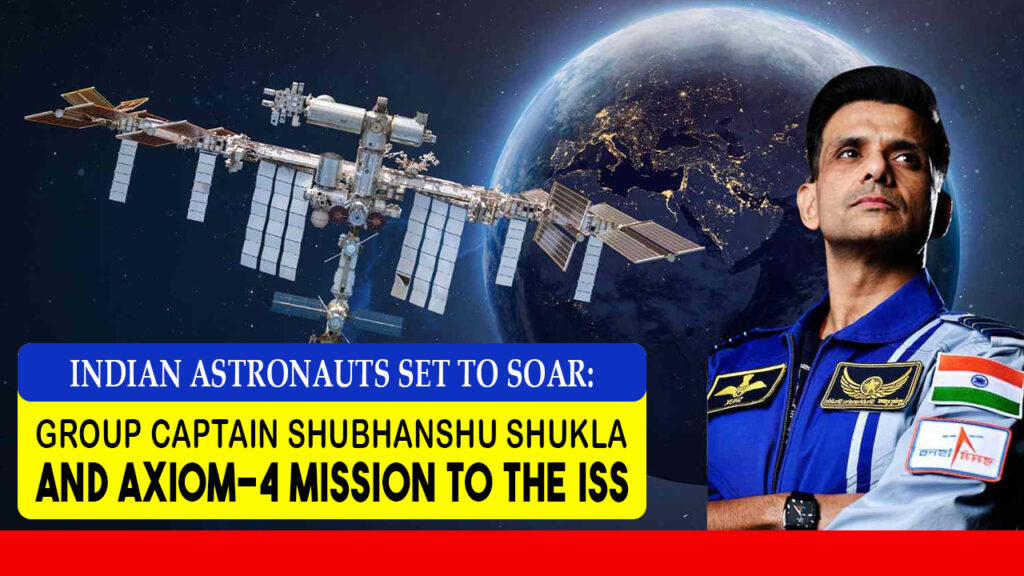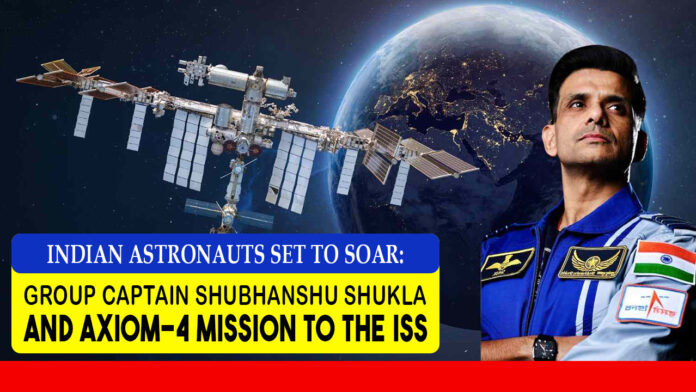🌍 Introduction
India’s dreams of reaching the stars are no longer just imagination—they’re a reality. With ISRO’s announcement that two Indian Air Force officers have completed the initial phase of training for Axiom-4 Mission (Ax-4), India takes another bold leap in human spaceflight. The heroes? Prime astronaut Group Captain Shubhanshu Shukla and backup astronaut Group Captain Prasanth Balakrishnan Nair.

👨🚀 Meet the Indian Heroes
Prime Astronaut – Group Captain Shubhanshu Shukla
A decorated test pilot with the Indian Air Force, Group Captain Shukla has clocked thousands of flying hours. Known for his sharp skills and calm demeanor under pressure, he’s an ideal choice for India’s representation in outer space.
Backup Astronaut – Group Captain Prasanth Balakrishnan Nair
A senior Air Force pilot and another gem in India’s aviation corps, Nair brings immense experience in high-stakes aerial operations, making him a reliable choice as backup astronaut.
Selection and Training Journey
These officers underwent rigorous assessments before being shortlisted by ISRO and Axiom Space. Training covered space survival, simulations, emergency response, weightlessness, and systems operation aboard SpaceX Crew Dragon.
🚀 What is the Axiom-4 Mission?
Background of Axiom Space
Axiom Space is a private US company aiming to build the first commercial space station. It partners with NASA and SpaceX to send international astronauts to the ISS.
The SpaceX Crew Dragon
This reusable spacecraft, developed by Elon Musk’s SpaceX, can carry up to seven astronauts. It will ferry the Ax-4 crew to the ISS, launched atop the Falcon 9 rocket.
Timeline and Mission Goals
Scheduled for late 2024, the Ax-4 mission will last around 14 days aboard the ISS. The aim? Conducting scientific research, educational outreach, and pushing the boundaries of commercial space ventures.
🎯 Key Objectives of the Mission
Commercial Space Ventures
This mission is a step toward developing private space tourism and commercial operations in Low Earth Orbit (LEO).
Global Scientific Research
The ISS provides a unique microgravity lab. Research areas include biotechnology, pharmaceuticals, and materials science.
Strengthening International Ties
With participants from multiple countries, Ax-4 showcases the collaborative spirit of global space missions.
🔬 Activities Onboard the ISS
Scientific Experiments
The astronauts will conduct Earth observation studies, test next-gen technologies, and participate in biomedical research.
Educational Outreach
They’ll engage with students globally via live sessions from space—making science cool for the next generation.
Technology Demonstration
Testing advanced robotics, AI systems, and 3D printing tools in zero gravity will be a core activity.
🛰️ The International Space Station (ISS)
Structure and Functionality
The ISS orbits Earth at 400 km altitude and is as big as a football field. It’s a flying lab, research base, and home all in one.
Countries Involved
ISS is jointly operated by NASA (USA), Roscosmos (Russia), ESA (Europe), JAXA (Japan), and CSA (Canada), with over 15 nations contributing.
Life in Space
Astronauts experience 16 sunrises a day. They float instead of walk, recycle their air and water, and eat space-optimized food.
🚀 India’s Growing Space Legacy
From Mangalyaan to Gaganyaan
India made headlines with Mangalyaan in 2013. Now, the manned Gaganyaan mission is next in line—targeted for post-2025.
Role of ISRO in Global Space Missions
ISRO’s low-cost, high-efficiency model makes it a trusted partner for global missions, from Mars to Moon.
Indo-US Space Cooperation
The 2023 joint statement between PM Modi and President Biden reaffirmed India’s participation in NASA’s Artemis Accords.
🌐 Significance of Indian Participation in Axiom-4 Mission
Global Representation
India’s presence on an international mission like Ax-4 boosts its soft power and leadership in the space sector.
Building Human Spaceflight Expertise
It gives ISRO valuable exposure ahead of Gaganyaan and future lunar missions.
Private Sector Partnerships
This mission opens doors for Indian startups in aerospace, biotechnology, and data analytics in space.
⚠️ Challenges and Preparations
Astronaut Training Regimes
Space training includes neutral buoyancy simulations, endurance drills, spacecraft systems, and orbital dynamics.
Risk Factors in Human Spaceflight
From cosmic radiation to micrometeorites and psychological stress, astronauts face numerous challenges—making training critical.
🧭 The Artemis Accords and India
Strategic Alignment with NASA
Joining Artemis Accords aligns India with lunar exploration goals and advanced tech exchanges.
Long-term Collaboration Scope
Future joint missions to Moon and Mars are now within the realm of possibility.
🏢 Commercial Space Stations: Future of Orbital Missions
Axiom’s Vision Beyond ISS
The ISS will retire around 2030. Axiom plans to build modules that will detach and form the first private space station.
Transition from ISS to Private Modules
Axiom-4 is the stepping stone—testing how private missions function alongside international ones.
📅 What’s Next After Ax-4?
Expected Outcomes for ISRO
ISRO will gain data, experience, and astronaut expertise crucial for its future manned missions.
Learning Curve for Future Missions
From zero-gravity acclimatization to life-support systems, each detail brings India closer to building its own human spaceflight program.
🏁 Conclusion
The inclusion of Indian astronauts in the Axiom-4 mission is more than symbolic—it’s strategic. It highlights India’s commitment to human spaceflight, international collaboration, and commercial space exploration. As the world watches Group Captain Shubhanshu Shukla prepare for liftoff, one thing is clear—India is not just reaching for the stars, it’s stepping among them.
❓ FAQs
1. Who are the Indian astronauts selected for Axiom-4?
Group Captain Shubhanshu Shukla (Prime) and Group Captain Prasanth Balakrishnan Nair (Backup) are the chosen ones for this historic mission.
2. What will they do aboard the ISS?
They’ll conduct scientific experiments, tech demos, and participate in educational outreach initiatives during their 14-day stay.
3. Why is the Ax-4 mission important for India?
It marks India’s debut in international human spaceflight missions, preparing the ground for Gaganyaan and future collaborations.
4. What is the role of ISRO in this mission?
ISRO partnered with NASA and Axiom Space for astronaut selection and training and will gain critical insights from the mission.
5. How does this mission connect with Gaganyaan?
It provides real-world spaceflight exposure to Indian astronauts—perfect training ahead of India’s own manned mission planned post-2025.




